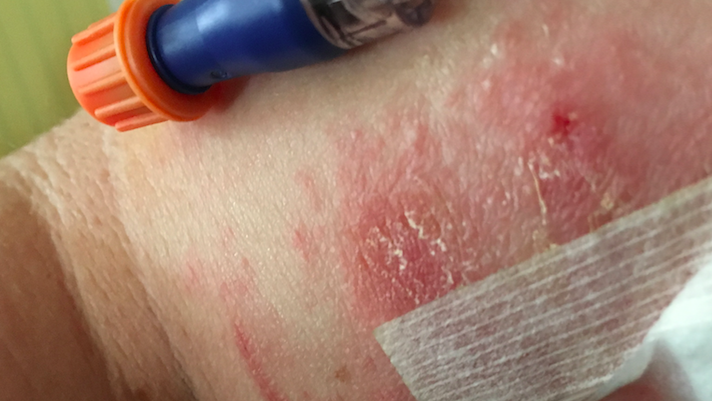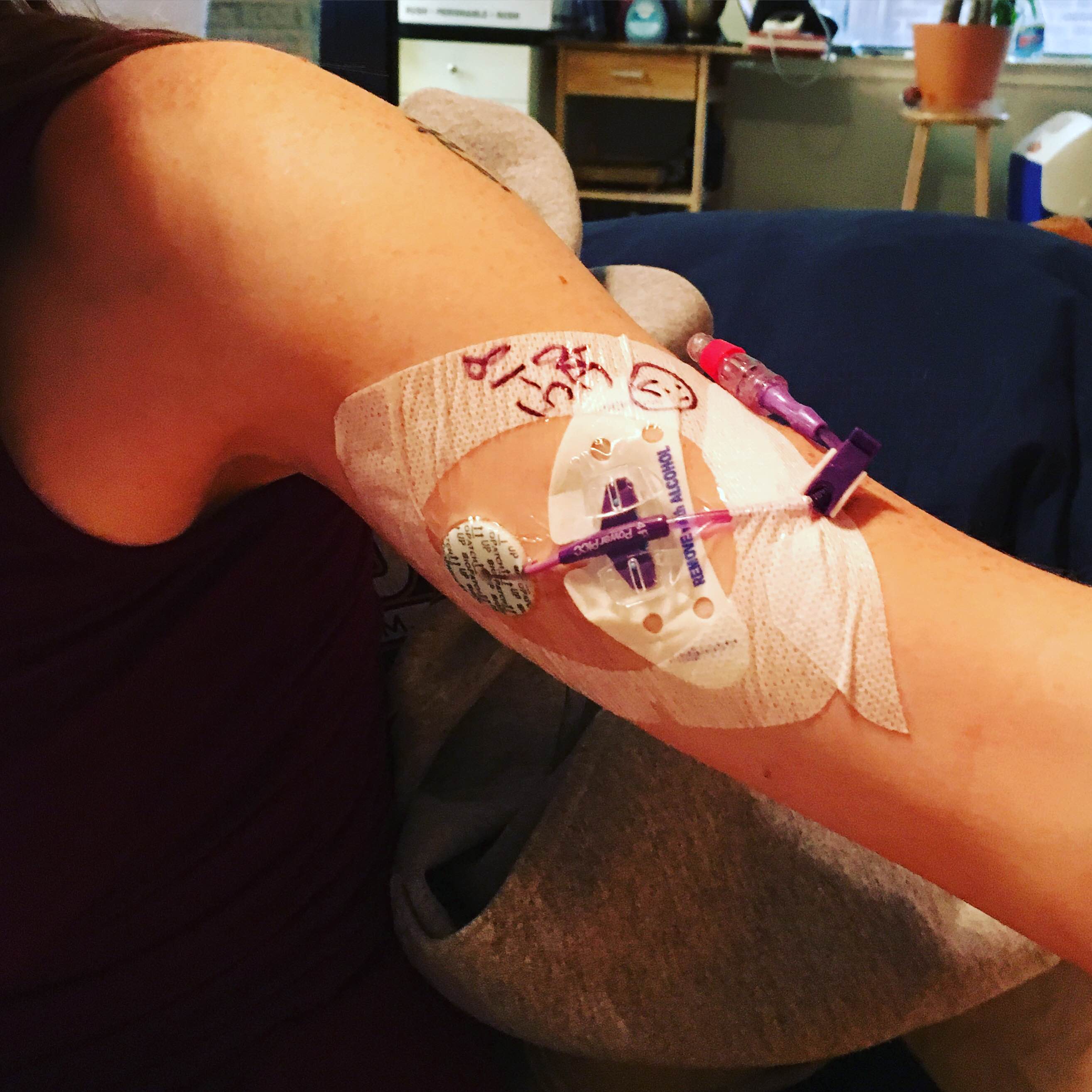If you’ve been recently diagnosed to require a PICC line, it can be overwhelming. To avoid PICC line complications, knowing how to take care of your PICC line is important. You will need to prioritize things like keeping your PICC line clean and maintaining hygienic dressing changes. Below you’ll learn about some common complications and how to address them.
Infection
The first thing to be wary of with your PICC line is the possibility of infection. The area where it goes into the vein is prone to infection, as the incision area gives germs access into your body. Most of the germs that can infect the PICC line come from your skin, so keeping the area around the catheter clean is crucial.
The PICC line will have a dressing over it to protect it from possible contamination from fluid, dirt, and germs. We recommend using a dressing that doesn’t cause any reactions on your skin. This will further help to keep your line clean, especially for people with sensitive skin. Your nurse or doctor will change the dressing for you, which should be done approximately every seven days. You can also wear an antimicrobial PICC Line Cover to help prevent germs and make your skin more comfortable. We’ve compiled a list of premium PICC products that can make it easier to care for your PICC.
To help prevent an infection
- Be sure to practice good hand hygiene by washing your hands with soap and water and using alcohol-based hand gels.
- Your clinician should also maintain proper hygiene. You should feel comfortable speaking up to your clinician if they are not following proper hand hygiene steps.
- The PICC line should also be kept dry at all times. Find the best ways to take a shower while keeping the dressing dry. If you get the dressing wet, contact your doctor immediately. And lastly, try avoiding touching the line, even after washing your hands.
- Should you see any redness, pain, or swelling near the catheter site or feel any pain or tenderness along the path of the catheter, these could be symptoms of a local infection. See your doctor without delay in such a case. If allowed to persist, this could result in bacteremia, a severe and possibly fatal condition of germs entering the bloodstream.

Dislodging the catheter
One of the more common PICC line complications is displacement. Displacement occurs when the line comes out, breaks, or splits. To prevent this, you should avoid activities that stress the arm or involve a lot of arm movement.
You might want to go easy in the gym and avoid lifting heavy weights. We don’t recommend abandoning exercise, but it should be light and not involve a lot of arm movement. If you’re a student, make sure to avoid carrying heavy backpacks as well.
In severe instances, the catheter may become damaged and even result in a catheter malposition, meaning that the line is no longer going to the intended target. Should this happen, the PICC line will have to be removed and replaced.
Wearing a well-fitting double-layer PICC Line Cover can help keep the catheter secured in place. By creating a pocket for the PICC to rest in between two layers, the external part of the PICC is not exposed, helping to prevent possible dislodgement due to patient movement/activity.

Getting air in the line
PICC lines usually have valves and caps at the end to stop air from coming in. The cap should always be closed when the line isn’t in use to prevent air from getting inside.
Air in the line can cause an air embolism, a potentially serious condition in which air gets into the veins. While it takes a large amount of air (50 ml or more) to cause problems, it’s best to minimize risk. Avoid touching or manipulating the valves on your line to prevent air from getting in.
The most common symptoms of an air embolism are a sudden onset of breathlessness, nausea, and shoulder or chest pain. If you experience any of these symptoms, you should see your healthcare provider immediately.
Blood clots
Another PICC line complication is when a blood clot forms in the vein, a condition known as thrombosis. These clots can lead to an inflammation of the veins or phlebitis. If you notice swelling, redness, or tenderness in your arm where the line is inserted, this could be a formation of a blood clot.
Superficial thrombophlebitis, while it sounds quite daunting, isn’t a serious condition and can be resolved with home treatment such as warm compresses and over-the-counter anti-inflammatory medications like ibuprofen. However, it can still be painful. Your doctor may give you medication to treat the blood clot. The bigger risk is when the clot occurs in a deep vein, where it may embolize or break off and travel to the lungs.
You can minimize the risk of a blood clot forming by ensuring proper circulation in your arms. If you are sedentary for long periods of time, make it a point to stand up and move around every couple of hours, and keep yourself hydrated by drinking plenty of water.
Living with a PICC line isn’t convenient, but with the right knowledge and a little care, you can go about your normal life with little incident. With proper tools and support you can minimize the risk of PICC line complications, so be sure to talk with your doctor and discover what works best for you.
Got more questions about PICC Lines? Check out our PICC Educational Hub for everything you need to know about PICCs. For more information on caring for your PICC, watch the video below.


10 Responses
Recently got a picc line and I’m very careful but infection seems quite frequently plus the tegaderm is causing water bubbles around the area as well
That sounds so tough! I hope your doctor / home care can find solutions soon. If you would like a community of people who’ve been there, feel free to share with the Friends in the Fight group. Sending Mighty Well Wishes ?
I’m hating my PICC line because I’m more than a little squeamish about it, but it’s better than wrecked veins. The one activity I have been told not to do is knit because of the repeated, identical, tiny movements which can apparently twist the tube internally and that’s very frustrating since knitting has always been a stress reliever for me. But needs must. My PICC-Perfect cover makes it more comfortable and looks good too.
I’m so sorry to hear that your PICC line has been tough! Crafting gets me through hard times, so that would be very sad for me as well. I’m so glad to hear the PICCPerfect cover is helping though! By the way, if it would ever help to be heard / ask for advice in a space with people who “get it,” you’re always welcome to join the Friends in the Fight facebook group. When my chronic illnesses flare, it helps me to connect with others who’ve been there. Good luck with your PICC!
If pic line feels itchy little warm slightly painful around sutures mean infection ? Or just irritation? I am already on antibiotics for another issue ..
Sorry for the delay — hopefully you brought these questions to your doctor and got it worked out!
I had Blood clot Blockage for three days and when I had PICC when it was removed I am having constant pain stabbing pain and tingly fingers from where the PICC was above my elbow to my fingers can it get worst and WHY
I’m so sorry to hear about that! It sounds like it could be nerve-related, but definitely ask your doctor and I hope it gets better soon!
What about painful itching around the dressing site? I guess it is called contact dermatitis or maybe just hives? Is that ever concerning or serious, and also do you have any advice for dealing with the itchiness?
That does sound like it might be contact dermatitis. Whether it’s concerning or serious is a question for your medical team, but it is common! You could ask your nurse to try different dressings (you might be allergic/sensitive to some brands over others). Also, this is a main reason why we created the PICCPerfect — it keeps the area protected and less irritated, and decreases the number of dressing changes needed: https://mighty-well.com/collections/all/picc-line-cover